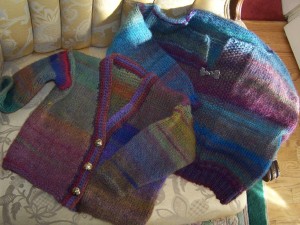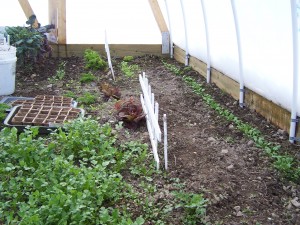Conservatory Gardening
Hoop houses are a wonderful way to extend the growing season, but what if you want to grow tropicals? The winter temperatures would still destroy these tender sun-loving plants. But even in this area it is possible to grow a West Virginia banana. The answer is to build a conservatory.
This a a picture of our conservatory. From the outside you cannot guess the treasure that lives within.

It is a true living room, where beneficial soil bacteria, and insects are actually encouraged to grow. The goal is to obtain a small ecosystem that balances itself with beneficial insects so that pesticides don’t ever have to be used. Since we don’t sell any plants, we are comfortable with a higher level of insects than many people might tolerate. We have also released batches of various beneficial insects to address any insect problems that did arise. When you walk through this building, you find spider webs and frogs, a salamander hops into the little goldfish pond – it’s all very ALIVE.

Here is a banana that is in “bloom,” called Musa Vente Cohol. It has pushed out immature banana clusters that will grow and ripen over the next several months. Behind, you can see an avocado tree that has not started to produce yet, despite being over 10 feet tall.
Here is a cluster of aloe vera growing in an area designated for more desert types of plants. This aloe vera is growing in the shadow of a cactus that is now about seven feet tall.

Here is a Monstera deliciosa producing a fruit. This kind of plant grows in the tropics and in some areas, like Hawaii, is considered invasive. It makes a gorgeous house plant, but in this case it is gradually taking over its corner of the conservatory. We regularly have to cut it back since it now sprawls over about 15 feet.

Another plant that has to be kept in check is the Bougainvillea. It is a thorny trailing plant that grows rather large and has paper like flowers in a bright fuchsia color. This plant grows in tropical climates, Florida, the British and U.S. Virgin Islands. It is said to have come from Brazil, where is grows abundantly. The Bougainvillea in this picture has to share its space with another Brazilian tree, the Jaboticaba. The Jaboticaba has an unusual way of growing its dark purple round fruits. Instead of hanging from the outer branches, the blossoms and eventual fruits come right out of the thicker parts of the trunk, looking like something Dr. Zeus might have thought up.

Citrus also does very well in this protected environment. Lemons, limes, grapefruit, mandarin and orange trees are all included, and we are lucky to have a couple producing fruit right now. Both the Kefir Lime, used in traditional Asian cooking, and the Naval Orange, have fruit, and they bloom several times a year, filling this living room with perfume.

Now for the techincal information. This conservatory was built on a cement and cinderblock foundation and was framed with 2×8 pressure treated pine. The center of the floor was left as dirt, and once the foundation was done several truck loads of compost and top soil were added. The trees and plants are planted directly in the ground. The walls are 3/4 inch polycarbonate, much thicker than greenhouse kits that are available. The conservatory, house and hot water are all heated with an outdoor wood burning furnace and this can be economical if you have enough wood so that you don’t have to buy it. In our case, we have enough forest that we can’t keep up with the standing dead trees, so for us this is feasible.
In the recent past is has been unpopular to burn wood – some people asserted it was bad for the environment. The opinion of envirnmentalists is changing however, since this is a renewable energy source. I am not fond of GreenPeace as an organization, especially its extremist positions and tactics, but one of its founders did say this:








